| Author |
Message |
|
Lafayette C Curtis
|
 Posted: Wed 07 Jan, 2009 7:59 am Post subject: Suitable crossbow for 15th-century mounted crossbowman Posted: Wed 07 Jan, 2009 7:59 am Post subject: Suitable crossbow for 15th-century mounted crossbowman |
 |
|
|
What kind of crossbow would be most appropriate for a mid- to late-15th century crossbowman--say, from the 1440s to the 1490s? I'd be especially grateful if anybody can post pictures to the specific crossbow(s) in question. Even slightly out-of-period iconography (late 14th, early 15th, or early 16th-century?) might be useful with the help of a little extrapolation.
|
|
  |
 |
Sean Flynt

|
|
   |
 |
Sean Flynt

|
|
   |
 |
Leo Todeschini
Industry Professional

|
|
   |
 |
Randall Moffett

|
 Posted: Wed 07 Jan, 2009 11:54 am Post subject: Posted: Wed 07 Jan, 2009 11:54 am Post subject: |
 |
|
By the 15th you see composite crossbows used with Goats foot levers from horseback. I am trying to think of a durer picture with it but cannot remember its proper name.
RPM
|
|
  |
 |
Sean Flynt

|
|
   |
 |
Sean Flynt

|
|
   |
 |
Sean Flynt

|
|
   |
 |
|
Jean-Carle Hudon
|
 Posted: Wed 07 Jan, 2009 2:19 pm Post subject: Posted: Wed 07 Jan, 2009 2:19 pm Post subject: |
 |
|
Write your own captions:
''When you're finished with it, can I have my bolt back?''
Bon coeur et bon bras
|
|
  |
 |
|
Richard Hare
Location: Alberta, canada Joined: 15 Mar 2008
Posts: 135
|
 Posted: Thu 08 Jan, 2009 7:34 am Post subject: Posted: Thu 08 Jan, 2009 7:34 am Post subject: |
 |
|
Caption;
..."Just look at your new armour!......I Told you to be careful playing with those things!"
Or;
"I guess it shoots low, ...I was aiming at the apple...."
Very good pics, Sean.
I'd really like to make a crossbow of this type, but proably a steel prod would make things easier.
Richard.
|
|
   |
 |
|
Lafayette C Curtis
|
 Posted: Sun 11 Jan, 2009 1:06 am Post subject: Posted: Sun 11 Jan, 2009 1:06 am Post subject: |
 |
|
|
That's a lot of eye candy indeed. I'm actually tempted to re-title this thread "Crossbow pr0n"....
|
|
  |
 |
|
James R.Fox
Location: Youngstowm,Ohio Joined: 29 Feb 2008
Posts: 253
|
 Posted: Sun 11 Jan, 2009 11:41 am Post subject: Posted: Sun 11 Jan, 2009 11:41 am Post subject: |
 |
|
Sirs-I have heard of light crossbows with the goatsfoot lever attached to the tiller of the bow. That's all I can think of, I've never seen one illustrated. That sounds practical for a horseman, and most of your illustrations would be French,as the English didnt use crossbows much. They used mounted longbowmen who got down to fight. The French were equally attached to the crossbow ,most ly mercenaries hired from Genoa, particularly the Grimaldis of Monaco, which was then part of Genoa(They also hired out war galleys, which were not terribly effctive in the Atlantic,except as coast guards.)
Ja68ms
|
|
   |
 |
Randall Moffett

|
 Posted: Sun 11 Jan, 2009 12:02 pm Post subject: Posted: Sun 11 Jan, 2009 12:02 pm Post subject: |
 |
|
James,
On the contrary the French employed well more of their own home grown french crossbowmen than genoese. Typically Genoese were hired for a specific purpose and time frame while you could get French crossbowmen anywhere and raise them for the army at will. Gascons also were well known as soldiers and crossbowmen in specific and much of gascony was French so this provided a useful recruitment ground as well. The reason people think the genoese were the French crossbow arm is just good PR
RPM
|
|
  |
 |
|
Lafayette C Curtis
|
 Posted: Sun 18 Jan, 2009 7:35 am Post subject: Posted: Sun 18 Jan, 2009 7:35 am Post subject: |
 |
|
And the Gascons were in English employ for quite a long while during the Hundred Years' War....
Anyway, returning to the topic, my cursory browsing through the database (and some other image galleries) seems to show that crossbows were more common among mounted men-at-arms than I had originally expected. All right, I was already thinking that the crossbow was more common than is usually thought, but I hadn't expected it to be that common. This thing raised two more questions in my head:
1. Does anybody have any ideas about whether that "more common" thing is real or just a statistical artifact of my search?
2. Some of those pictures leave me wondering about how the crossbow is attached (if at all) to the saddle or to the horseman. Any recommendations about where I should look for more information about these attachment methods?
|
|
  |
 |
|
Lafayette C Curtis
|
 Posted: Fri 13 Nov, 2009 7:05 am Post subject: Posted: Fri 13 Nov, 2009 7:05 am Post subject: |
 |
|
I've still had no luck with looking for the attachment method that a mounted crossbowman would have used to secure his crossbow when it's not held in his hands. It seems like such a method would have been necessary since at least some troops of mounted crossbowmen were supposed to engage in hand-to-hand combat (see Seldeneck) and I doubt that they were instructed to club their enemies with their crossbow tillers. But even greatly zoomed-in views of the medieval images I've found (both through this thread and elsewhere) isn't really producing any leads yet.
I hope it's not one of those things that medieval artists considered too obvious to be worth the bother of representing them....
|
|
  |
 |
|
Nathan Quarantillo
Location: Eastern Panhandle WV, USA Joined: 14 Aug 2009
Posts: 281
|
 Posted: Sat 14 Nov, 2009 5:45 pm Post subject: Posted: Sat 14 Nov, 2009 5:45 pm Post subject: |
 |
|
did they unstring medieval crossbows? if they did, then how? also, what are some good reproducions out there? anyone got any experience w/ hollow earth crossbows? and, is 3/4 plate good for a crossbowman (man-at-arms)? what helms did they use (late 15th cent early 16th cent.) and lastly, did the mounted crossbowman have a form or paviase or other shield w/ him?
“He who has a why to live for can bear almost any how.” ― Friedrich Nietzsche
|
|
  |
 |
|
Jason Daub
|
 Posted: Sat 14 Nov, 2009 9:40 pm Post subject: Crossbow case Posted: Sat 14 Nov, 2009 9:40 pm Post subject: Crossbow case |
 |
|
Lafayette,
Sean linked to the book "Venus and Mars-The World of the Medieval Housebook" earlier, mentioning two mounted crossbowmen. If you look at 21v22r, one of the bows is shown in a case at the saddlebow, the actual attachment to the saddle is not shown but it appears as if it may be strapped on. It isn't much to go on, and I don't recall any other images of mounted crossbowmen who were not holding the weapon.
'I saw young Harry, -with his bevor on,
His cuisses on his thighs, gallantly arm'd,-
Rise from the ground like feather'd Mercury,
And vaulted with such ease into his seat,
As if an angel dropp'd down from the clouds,
To turn and wind a fiery Pegasus,
And witch the world with noble horsemanship.'
|
|
  |
 |
|
Lafayette C Curtis
|
 Posted: Wed 25 Nov, 2009 3:31 am Post subject: Posted: Wed 25 Nov, 2009 3:31 am Post subject: |
 |
|
|
Yeah. I haven't bought that book yet, hence my cluelessness. Since you pointed to a specific illustration that may give me a bit more clue than I already have, though, it has moved up several places on my to-buy list.
|
|
  |
 |
Benjamin H. Abbott

|
 Posted: Tue 07 Jan, 2014 8:35 pm Post subject: Posted: Tue 07 Jan, 2014 8:35 pm Post subject: |
 |
|
|
When Sir John Smythe promoted mounted crossbowers at the end of the sixteenth century, he wanted them equipped gaffles or goat's-foot levers. He noted how mounted crossbowers had seen considerable service in earlier European warfare. I don't know of any evidence that much/anything came of Smythe's attempts to revive the mounted crossbower, though.
|
|
  |
 |
Mark T

|
 Posted: Mon 21 Jul, 2014 8:59 pm Post subject: Posted: Mon 21 Jul, 2014 8:59 pm Post subject: |
 |
|
| Lafayette C Curtis wrote: | I've still had no luck with looking for the attachment method that a mounted crossbowman would have used to secure his crossbow when it's not held in his hands. It seems like such a method would have been necessary since at least some troops of mounted crossbowmen were supposed to engage in hand-to-hand combat (see Seldeneck) and I doubt that they were instructed to club their enemies with their crossbow tillers. But even greatly zoomed-in views of the medieval images I've found (both through this thread and elsewhere) isn't really producing any leads yet.
I hope it's not one of those things that medieval artists considered too obvious to be worth the bother of representing them.... |
I'm still slowly working up to commissioning a bow from Tod, and am interested in this question also.
The only lead I've found so far is this from David Watson of New World Arbalest, posting as 'Geezer' on The Arbalist Guild:
| Quote: | | If you use a cranequin, the top of the stock will be upper most, but you may have either the butt or the fore-end (usually there's a little hanging-ring rather than a stirrup at the front) against your leg or belly, depending on the type of cranequin you're using. I have seen some illus of Spanish cranequins being spanned with butt against the body and the bow pointing out ahead of the shooter, more or less level. [emphasis added] |
[Source: http://thearbalistguild.forumotion.com/t154-spanning-a-crossbow]
I noticed that Tod has a small ring, rather than foot stirrup, for many of his bows posted on myA ... I wonder if Tod or David have any other leads, then, about exactly how these rings were used ... would they have been hung from the saddle? Out of the saddle, would they have ever been hung from the belt, or only ever carried? In either case, what would the attachment mechanism have been - tied on with thonging? Some kind of quick-release buckle arrangement? Or hung off some kind of hook?
I'll ask Tod about it directly also, but to save me bothering him with too many questions, I thought I'd ask here first! 
One thing I really like about these hanging-rings - apart from their historical accuracy in and of itself - is that it would clearly show that the bow needs a cranequin (or other device) to span, would be wholly appropriate for a mounted crossbowman, and would stand out from the stirrup-mounted low-poundage bows seen at living history events.
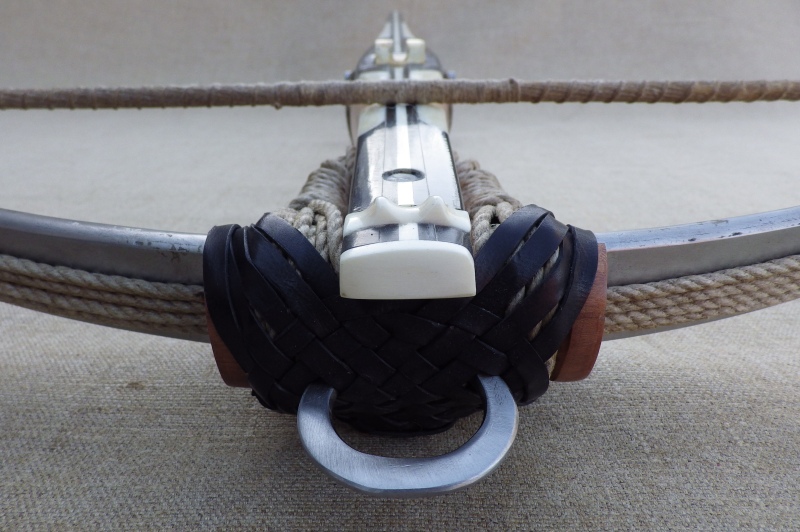
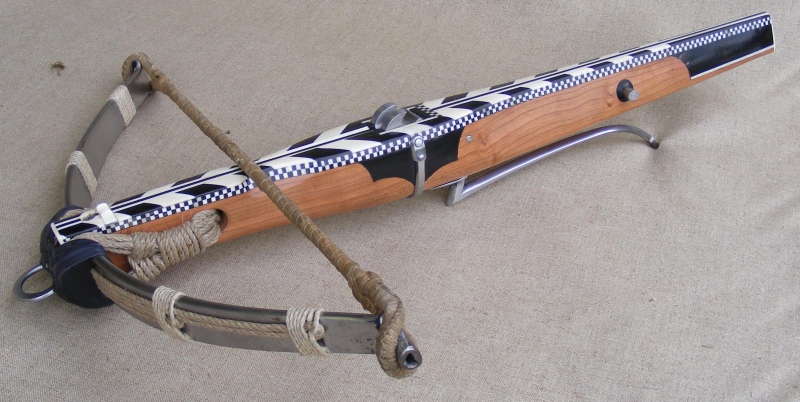
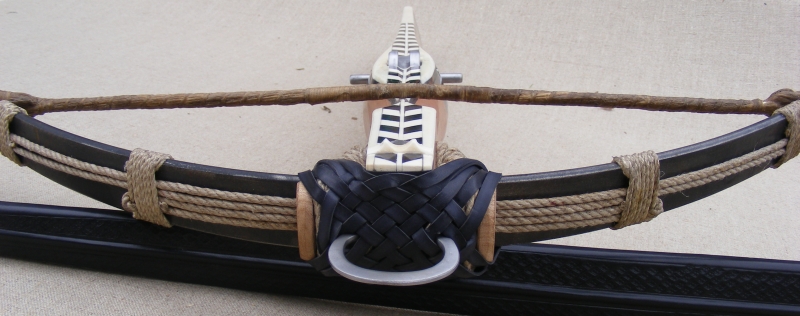
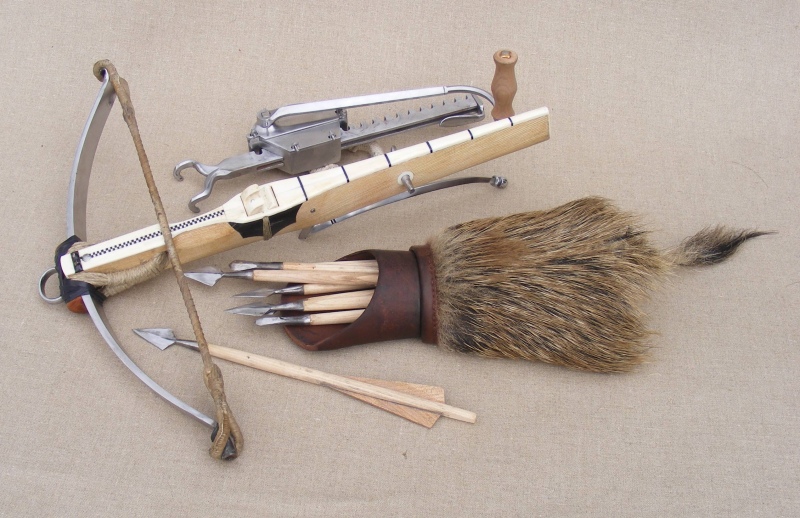
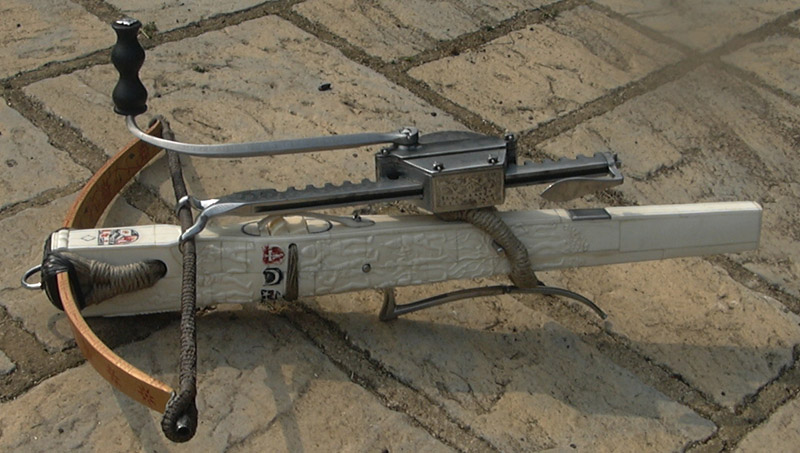
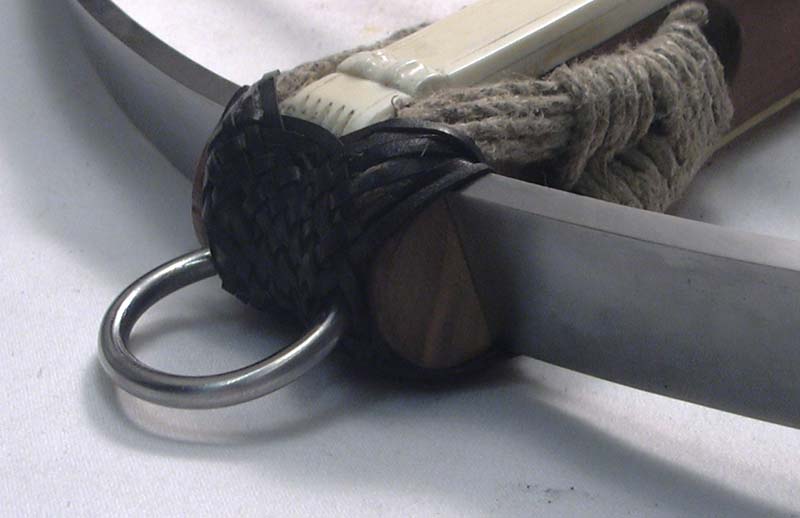
Chief Librarian/Curator, Isaac Leibowitz Librarmoury
Schallern sind sehr sexy!
|
|
  |
 |
|
|

